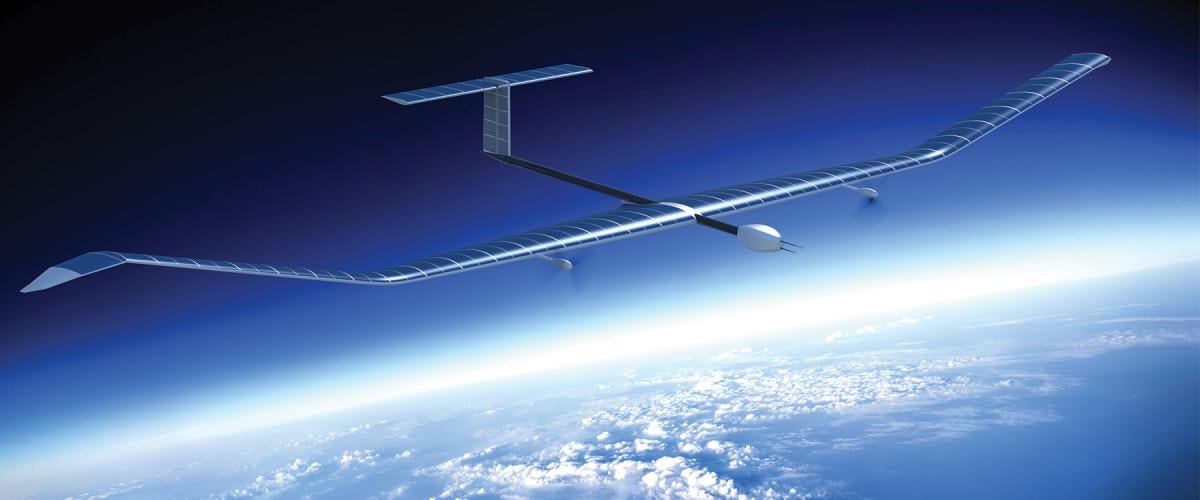High-altitude pseudo-satellite (HAPS) unmanned aerial vehicles (UAVs) are moving rapidly toward maturity, thanks to trends in solar power, battery storage, and artificial intelligence (AI). HAPS could provide a key capability bridge for forces seeking to operate in areas defended by anti-access/area-denial (A2/AD) capabilities. Launched from outside the range of A2/AD systems, a fleet of HAPS with various capabilities operating alone or in concert could support various forces on the ground. Their capabilities could enhance communication, sensing, and intelligence capabilities for long periods with minimal logistical support requirements.1 This makes HAPS highly attractive for supporting multiple purposes, including expeditionary advanced base operations.
HAPS have applications across a variety of missions.2 Experimentation with EABO has already produced musings about unconventional methods for sustainment and supporting combat through innovative technologies. Marines struggling to deal with the vast distances covered in these types of operations would benefit from the capabilities that HAPS will soon provide.
Operating at altitudes of 65,000 feet and higher, HAPS UAVs can bridge gaps between space-based assets and air-breathing platforms below. They are ultralight platforms with beyond line-of-sight communication and are controllable from remote locations. They are designed to be modular, carrying payloads that include a variety of sensors and navigation capabilities.3
A convergence of emerging technologies makes HAPS possible: efficient solar power, better batteries, and the emergence of AI. The combination gives HAPS nearly unlimited range (except in cases of system failure); the UAVs can dwell for months. Combustion engines and precharged lithium-ion batteries, on which most tactical and operational UAVs rely, limit range and mission duration. Solar energy and in-flight battery recharging would allow very-long-duration flights.
Not very many years ago, solar power would have been inadequate for powering an aircraft for extended periods. The efficiency of photovoltaic solar panels has steadily improved since their advent in the 1950s, their adoption for use in space in the 1960s and 70s, and the development of thin film variations that first exceeded 10 percent efficiency in the 1980s. Researchers at Stanford University achieved 25 percent efficiency in 1985, and, in 2020, experimental solar technologies reached efficiencies as high as 47 percent.4 This has increased the pace at which solar power can be applied to cutting-edge concepts such as HAPS.
Batteries ensure continued power during darkness. Advances over the past decade have improved energy density while decreasing battery costs by 85-plus percent. Some companies are pursuing research that may provide perhaps five times the energy and six times the power.5 Lithium-ion batteries are constantly improving, and new materials such as lithium-sulfur promise increased resistance to degradation from cold temperatures, life-spans of ten years, and more sustainable sources for the raw materials (with plentiful sulfur replacing rare cobalt).6
The development of AI is another key to building a viable HAPS capability. The operational value of a single UAV is limited by its relatively small payload. Any single type of sensor or communication suite can easily be defeated by weather, enemy, or terrain elements and must be complemented by robust alternatives. The optimal employment of HAPS is as a networked constellation, mixing and matching capabilities that work in concert to provide support. This concept of employment is something that benefits from advanced computing and AI to integrate and maximize them usefully. Furthermore, the ability of these systems to sort and pre-evaluate the value of specific data is a key component of a successful manifestation of these systems.
Large, high-fidelity data packets clog bandwidth and can overwhelm forces on the receiving end, doing more harm than good. The same can be said of constellations of support assets too unwieldy to manage and integrate. AI-driven battle management systems are already in development, and the United States is investing heavily in future AI capabilities, with $300 million in funding authorized in the fiscal year 23 National Defense Authorization for AI technologies.7 Improvements in AI integration could allow HAPS UAVs to operate effectively in a networked mesh. They promise much more rapid processing and dissemination of battlefield information than is possible by human operators.8
A variety of HAPS platforms have been in development for several years. Notable examples include the BAE Phasa-35 and the Leonardo Skydweller.9 One of the most promising is the Airbus Zephyr, with a cost estimated in 2016 of $10 to $20 million each.10 During an impressive test flight in the summer of 2022, Zephyr scored several firsts for HAPS. The UAV surpassed its own 2018 world record for UAVs of 26 days, completing more than 63 days of continuous flight. During this period it was flown from Yuma Proving Ground, Arizona, through international airspace to Belize, and back.11 It conducted its first flight in international airspace, first control from beyond line-of-sight through satellite communications, first direct downlink of information to a forward ground station, and first flight over water.12 These achievements are elements that would be required for successful employment during EABO-type engagements.
The development and integration of HAPS into the force may be key to enhancing the survivability of communication capabilities and ISR availability. HAPS offer an attritable solution considering the cost of satellites and the increased range requirements for aircraft that A2AD bubbles cause. HAPS also promise to be more flexible than satellites, whose orbits limit what they can see.
The ultralight construction of many of these pseudo-satellites limits payload capacity compared with conventional UAVs or aircraft, but this simplified swapping sensors for different missions and upgrading them without requiring a new platform. ISR data from electro-optical systems, synthetic-aperture radar, and infrared systems could be gathered and merged selectively by a central processing algorithm that would allow the most relevant data to be transmitted across limited bandwidth. The modularity of HAPS means this could be an ideal manifestation of a decentralized, networked asset concept.
Weather, including cloud coverage, will be a challenge for an observation platform operating at 60,000 to 70,000 feet, affecting optical imagery in particular. Using a constellation of HAPS with a variety of sensors would help mitigate that. High operating altitudes will keep HAPS above most convective weather and avoid some of the common weather hazards that affect lower-flying UAVs.13 This does not mean that HAPS are immune to weather concerns. While the cause of the 2022 crash of the Zephyr ZULU-82 flight is unknown, the wind conditions on the ground were not suitable for the UAV to attempt a safe landing.14
Weather hazards are not the only risk to HAPS employed for EABO support. High operating altitudes help mitigate the risks posed by many air-defense systems, but they are not completely immune. Strategic competitors continue to invest in kinetic weapons, laser dazzlers, and high-power microwave weapons that could fry the electronics or destroy a HAPS entirely. Cyberattacks also could disrupt a HAPS, and although such attacks generally require extensive planning, they have a low resource barrier to their use.
The future operating environment promises to be challenging, as new technologies and emerging adversarial powers create novel challenges to overcome. Conducting operations across vast and nonpermissive environments is even more daunting. Adversary capabilities may deny much of the air support that U.S. forces have come to depend on, as risk pushes asset staging and launch locations beyond their ability to reach the battlefield. HAPS fill a niche between more capable but more vulnerable, shorter-range air-breathing assets and expensive satellites that are better protected but lack flexibility, numbers, and replaceability.
Editor's note: This article has been updated to eliminate reference to the Airbus Zephyr's participation in the Army's Project Convergence. This was originally planned but ultimately did not come to pass. Airbus contacted Proceedings to note that the 2016 pricing estimates were correct at the time but that the company will be releasing new, lower estimates soon.
1. Pedro Junior Vicente Valdez and Paulina Wheeler, “High Altitude Pseudo-Satellites: A Technology Primer,” On the Radar, Center for Strategic and International Studies, June 2019.
2. Evan A. Karlik, “Bring Flexibility to FONOPs with HAPS,” U.S. Naval Institute Proceedings 146, no. 12 (December 2020).
3. Valdez and Wheeler, “High Altitude Pseudo-Satellites: A Technology Primer.”
4. National Renewable Energy Laboratory, “Best Research-Cell Efficiencies,” June 2022.
5. U.S. Department of Energy, “Executive Summary: National Blueprint for Lithium Batteries 2021–2030,” June 2021.
6. Kate McAlpine, “1,000-Cycle Lithium-Sulfur Battery Could Quintuple Electric Vehicle Ranges,” Michigan News, University of Michigan, January 2022.
7. Inder Singh Bisht, “U.S. Army’s Prometheus AI Software to Increase Sensor, Shooter Capabilities,” Defense Post, 29 October 2020; and Senate Armed Services Committee, “FY23 NDAA Bill Report,” 82.
8. John F. Antal, Seven Seconds to Die: A Military Analysis of the Second Nagorno-Karabakh War and the Future of Warfighting (Philadelphia, PA: Casemate, 2022), 113–16.
9. BAE Systems, “PHASA-35,” www.baesystems.com/en-us/product/phasa-35-#section3; and Tom Kingston, “Leonardo Invests in ‘Fully Electric’ Skydweller Drone,” Defense News, November 2019.
10. Lewis Page, “Airbus Zephyr: The Eternal High-Altitude Surveillance Sun-Drone,” Ars Technica, February 2016.
11. Joseph Trevithick, “Zephyr Drone Has Been Flying for 17 Days from Arizona to Belize,” The War Zone, 1 July 2022.
12. Tim Robinson, “Zephyr—Down But Definitely Not Out,” Royal Aeronautical Society, 26 August 2022.
13. S. E. Campbell, D. A. Clark, and J. E. Evans, “Preliminary Weather Information Gap Analysis for UAS Operations,” Lincoln Laboratory, Massachusetts Institute of Technology, November 2017.
14. Robinson, “Zephyr—Down But Definitely Not Out.”
15. Todd Harrison, Kaitlyn Johnson et al., “Space Threat Assessment 2022,” Center for Strategic and International Studies, April 2022, 4–5.







